|
|
|
Sort Order |
|
|
|
Items / Page
|
|
|
|
|
|
|
| Srl | Item |
| 1 |
ID:
117220


|
|
|
|
|
| Publication |
2013.
|
| Summary/Abstract |
Electricity generation presently contributes approximately 30% of United Kingdom (UK) carbon dioxide (CO2) emissions (Alderson et al., 2012 and Parliamentary, 2007), the principal 'greenhouse gas' (GHG) having an atmospheric residence time of about 100 years (Hammond, 2000). This share mainly arises from the use of fossil fuel (coal and natural gas) combustion for this purpose. Changes in atmospheric concentrations of GHGs affect the energy balance of the global climate system. Human activities have led to quite dramatic increases since 1950 in the 'basket' of GHGs incorporated in the Kyoto Protocol; concentrations have risen from 330 ppm to about 430 ppm currently (IPCC, 2007). Prior to the first industrial revolution in the 18th Century the atmospheric concentration of 'Kyoto gases' was only some 270 ppm. The cause of the observed rise in global average near-surface temperatures over the second half of the 20th Century has been a matter of dispute and controversy. But the most recent (2007) scientific assessment by the Intergovernmental Panel on Climate Change (IPCC) states with 'very high confidence' that humans are having a significant impact on the global warming (IPCC, 2007). They argue that GHG emissions from human activities trap long-wave thermal radiation from the Earth's surface in the atmosphere (not strictly 'greenhouse' phenomena), and that these are the main cause of rises in climatic temperatures. In order to mitigate anthropogenic climate change, the Royal Commission on Environmental Pollution in the UK (RCEP, 2000) recommended at the turn of the Millennium a 60% cut in UK CO2 emissions by 2050. The British Government subsequently set a tougher, legally binding target of reducing the nation's CO2 emissions overall by 80% by 2050 in comparison to a 1990 baseline ( Department of Trade and Industry [DTI], 2007 and Climate, 2008).
|
|
|
|
|
|
|
|
|
|
|
|
|
|
|
|
| 2 |
ID:
180142


|
|
|
|
|
| Summary/Abstract |
In 2016 and as part of its commitment under the 2015 Paris Agreement, China submitted its First Nationally Determined Contribution (NDC), outlining its ‘best efforts’ to limit greenhouse gas emissions. In 2017, the country accounted for 26% of global carbon emissions, stemming mostly from coal-based electricity generation and mining. The United States, by comparison, accounted for nearly 14%, and the European Union, almost 10%. In view of this disparity and the significance of China's contribution to achieving global emissions targets and sustainability, we revisit its First NDC. We argue that, while China is set to meet its non-fossil fuel targets, progress on its fossil fuel targets is stymied by continual coal development, which has negative implications for the Paris 2 °C limit. We contend that the country's focus on carbon-intensive economic expansion is a major barrier to greater climate ambition, especially when considering its growing portfolio of overseas investments in fossil fuel-dependent sectors. In bringing together disparate arguments from across the energy policy literature and looking ahead to its Second NDC, we conclude by making four recommendations for increasing China's climate ambition and centering a just transition to clean energy.
|
|
|
|
|
|
|
|
|
|
|
|
|
|
|
|
| 3 |
ID:
169862


|
|
|
|
|
| Summary/Abstract |
We analyze the spatial and technological distribution of China's overseas electric power investments around the world, and the pollution intensity of Chinese coal fired power plants relative to those held by non-Chinese entities. We find that Chinese firms hold approximately $115 billion USD in electric power assets globally, with an average of 73% ownership stake in a total capacity of 81 GW. Chinese power investments span the globe but are largely found in developing countries, particularly in Asia and Latin America. The vast majority of Chinese investment goes to coal (24.5 GW), gas (20.5 GW) and hydropower (18.1 GW), while the share of wind (7.2 GW) and solar (3.1 GW) is relatively small but may be rising. The energy mix of Chinese overseas investment is similar to the existing world portfolio. Within the coal sector, between 2011 and 2017, the majority of Chinese greenfield investment in coal used supercritical technologies (58 percent) while only 34 percent of non-Chinese coal plants built during this period were supercritical.
|
|
|
|
|
|
|
|
|
|
|
|
|
|
|
|
| 4 |
ID:
150048


|
|
|
|
|
| Summary/Abstract |
A common strategy for reducing greenhouse gas (GHG) emissions from energy use is to increase the supply of low-carbon alternatives. However, increasing supply tends to lower energy prices, which encourages additional fuel consumption. This “fuel market rebound effect” can undermine climate change mitigation strategies, even to the point where efforts to reduce GHG emissions by increasing the supply of low-carbon fuels may actually result in increased GHG emissions. Here, we explore how policies that encourage the production of low-carbon fuels may result in increased GHG emissions because the resulting increase in energy use overwhelms the benefits of reduced carbon intensity. We describe how climate change mitigation strategies should follow a simple rule: a low-carbon fuel with a carbon intensity of X% that of a fossil fuel must displace at least X% of that fossil fuel to reduce overall GHG emissions. We apply this rule to the United States Renewable Fuel Standard (RFS2). We show that absent consideration of the fuel market rebound effect, RFS2 appears to reduce GHG emissions, but once the fuel market rebound effect is factored in, RFS2 actually increases GHG emissions when all fuel GHG intensity targets are met.
|
|
|
|
|
|
|
|
|
|
|
|
|
|
|
|
| 5 |
ID:
151007


|
|
|
|
|
| Summary/Abstract |
The Paris Agreement on Climate Change was adopted at the close of the 21st Conference of Party on 12 December 2015. This agreement has been approved after a marathon negotiation in which parties under the aegis of the United Nations have finally agreed on the terms and conditions to implement it by 2020. The prime objective of the Paris Agreement is to ensure member states of the United Nations take appropriate and concrete actions in combating the menace of climate change that poses a challenging threat to humanity. It includes keeping temperature rise below 2°C by this century and limiting the temperature increase even further to 1.5°C above the pre-industrial levels. India has announced voluntary pledges during the conference which include carbon intensity growth by 33–35 per cent over the 2005 level, to raise the share of non-fossil fuel power to 40 per cent by 2030 and to produce 175 gigawatt (GW) of renewable power by 2022. Hence, the basic objective of this article is to examine India’s commitments and its initiatives to combat climate change in line with the Paris framework agreement to be implemented by 2020 and also to highlight the implications and drawbacks which India confronted.
|
|
|
|
|
|
|
|
|
|
|
|
|
|
|
|
| 6 |
ID:
116329


|
|
|
|
|
| Publication |
2012.
|
| Summary/Abstract |
Turkey's energy consumption is low compared to its young population. However, energy consumption is rapidly increasing as a result of economic growth in recent years, a trend which is expected to continue. Accordingly, guaranteeing adequate energy supply for its growing economy remains at the top of the governmental agenda. While energy consumption is increasing, Turkey is becoming increasingly dependent on fossil fuel imports, especially in oil and natural gas. Increasing awareness toward the environmental issues, energy prices and lack of diversification are the most immediate threats. All these are significant threats to Turkish energy security and thus have become a greater focus of attention. In response, Turkish energy policy is developing into a multi-dimensional one, considering the primary goals of securing energy supply and increasing the level of diversification and decreasing environmental effects. Accordingly, these considerations have tended to endorse renewable energy. Renewable energy resources are emerging as one of the most efficient, indigenous and effective solutions for clean and sustainable energy development in Turkey. Its geographical location allows extensive use of most types of renewable sources. This paper analyzes the current and possible future contribution of renewable energy in Turkish energy policy, considering supply security, diversification and environmental concerns.
|
|
|
|
|
|
|
|
|
|
|
|
|
|
|
|
| 7 |
ID:
128027
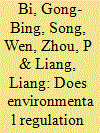

|
|
|
|
|
| Publication |
2014.
|
| Summary/Abstract |
Data envelopment analysis (DEA) has gained much popularity in performance measurement of power industry. This paper presents a slack-based measure approach to investigating the relationship between fossil fuel consumption and the environmental regulation of China's thermal power generation. We first calculate the total-factor energy efficiency without considering environmental constraints. An environmental performance indicator is proposed through decomposing the total-factor energy efficiency. The proposed approach is then employed to examine whether environmental regulation affects the energy efficiency of China's thermal power generation. We find that the environmental efficiency plays a significant role in affecting energy performance of China's thermal generation sector. Decreasing the discharge of major pollutants can improve both energy performance and environmental efficiency. Besides, we also have three main findings: (1) The energy efficiency and environmental efficiency were relatively low. (2) The energy and environmental efficiency scores show great variations among provinces. (3) Both energy efficiency and environmental efficiency are of obvious geographical characteristics. According to our findings, we suggest some policy implications.
|
|
|
|
|
|
|
|
|
|
|
|
|
|
|
|
| 8 |
ID:
133031


|
|
|
|
|
| Publication |
2014.
|
| Summary/Abstract |
China has adopted targets for developing renewable electricity that would require expansion on an unprecedented scale. During the period from 2010 to 2020, we find that current renewable electricity targets result in significant additional renewable energy installation and a reduction in cumulative CO2 emissions of 1.8% relative to a No Policy baseline. After 2020, the role of renewables is sensitive to both economic growth and technology cost assumptions. Importantly, we find that the CO2 emissions reductions due to increased renewables are offset in each year by emissions increases in non-covered sectors through 2050. We consider sensitivity to renewable electricity cost after 2020 and find that if cost falls due to policy or other reasons, renewable electricity share increases and results in slightly higher economic growth through 2050. However, regardless of the cost assumption, projected CO2 emissions reductions are very modest under a policy that only targets the supply side in the electricity sector. A policy approach that covers all sectors and allows flexibility to reduce CO2 at lowest cost - such as an emissions trading system - will prevent this emissions leakage and ensure targeted reductions in CO2 emissions are achieved over the long term.
|
|
|
|
|
|
|
|
|
|
|
|
|
|
|
|
| 9 |
ID:
118104
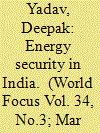

|
|
|
| 10 |
ID:
085276


|
|
|
| 11 |
ID:
178839


|
|
|
|
|
| Summary/Abstract |
This study aligns with Sustainable Development Goal 7 which aims at “ensuring access to affordable, clean energy, reliable, sustainable and modern energy for all”. The Gazetted Flare Gas Regulations 2018 provides a legal framework to support the policy objectives of the Federal Government for the reduction of Green House Gas emissions through the flaring and venting of natural gas. The Regulations provide the legal basis for the implementation of the Nigerian Gas Flare Commercialization Programme. This study investigates the factors contributing to gas flaring activities in Nigeria from 1970 to 2019. Using the autoregressive distributed lag error correction representation and cointegration techniques, findings reveal, among others, that in the long-run: (1) gas flaring activities is persistent; (2) economic growth induces flaring activities; (3) gas prices exert asymmetric impact; (4) gas utilization and fossil fuel are negative predictors. The result shows that gas price contemporaneously exerts positive and statistically significant impact at the 1% level. Gas price contributes 0.187 percent increase to gas flaring while its first lag induces significant reduction in gas flaring by 0.293 percent at 1 percent level of significance. This study also provides sufficient evidence on the persistency of gas flaring activities in Nigeria.
|
|
|
|
|
|
|
|
|
|
|
|
|
|
|
|
| 12 |
ID:
183047


|
|
|
|
|
| Summary/Abstract |
This paper investigates the impact of the Swiss CO2 levy on households' heating demand. Using a difference-in-differences approach combined with inverse probability of treatment weighting, we test whether the 2016 and 2018 carbon tax rate increases had a short-run impact on Swiss households' heating and hot water expenditures—i.e. a proxy for heating consumption. Micro-level data from the Swiss Household Energy Demand Survey are used to estimate the models. Our regression analysis shows that heating consumption decreases with time for all households, but it does not detect any clear short-run impact of the CO2 levy on fossil fuel users in comparison to non-fossil fuel users. We nevertheless find that many factors significantly affect heating consumption, such as setting the thermostat at a lower temperature. Even though further research is needed regarding possible long-run impacts, our findings challenge the relevance of this policy instrument under its current form to lower households’ CO2 emissions. Considering that its rate is regularly increased based on short-run emission targets, households may have too little time to adapt. The tax design might thus need to be revised to take into account the slow reaction time.
|
|
|
|
|
|
|
|
|
|
|
|
|
|
|
|
| 13 |
ID:
151005
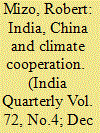

|
|
|
|
|
| Summary/Abstract |
The Paris Agreement on Climate Change was adopted at the close of the 21st Conference of Party on 12 December 2015. This agreement has been approved after a marathon negotiation in which parties under the aegis of the United Nations have finally agreed on the terms and conditions to implement it by 2020. The prime objective of the Paris Agreement is to ensure member states of the United Nations take appropriate and concrete actions in combating the menace of climate change that poses a challenging threat to humanity. It includes keeping temperature rise below 2°C by this century and limiting the temperature increase even further to 1.5°C above the pre-industrial levels. India has announced voluntary pledges during the conference which include carbon intensity growth by 33–35 per cent over the 2005 level, to raise the share of non-fossil fuel power to 40 per cent by 2030 and to produce 175 gigawatt (GW) of renewable power by 2022. Hence, the basic objective of this article is to examine India’s commitments and its initiatives to combat climate change in line with the Paris framework agreement to be implemented by 2020 and also to highlight the implications and drawbacks which India confronted.
|
|
|
|
|
|
|
|
|
|
|
|
|
|
|
|
| 14 |
ID:
094833
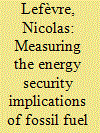

|
|
|
|
|
| Publication |
2010.
|
| Summary/Abstract |
Economic assessments of the welfare effects of energy insecurity are typically uncertain and fail to provide clear guidance to policy makers. As a result, governments have had little analytical support to complement expert judgment in the assessment of energy security. This is likely to be inadequate when considering multiple policy goals, and in particular the intersections between energy security and climate change mitigation policies. This paper presents an alternative approach which focuses on gauging the causes of energy insecurity as a way to assist policy making. The paper focuses on the energy security implications of fossil fuel resource concentration and distinguishes between the price and physical availability components of energy insecurity. It defines two separate indexes: the energy security price index (ESPI), based on the measure of market concentration in competitive fossil fuel markets, and the energy security physical availability index (ESPAI), based on the measure of supply flexibility in regulated markets. The paper illustrates the application of ESPI and ESPAI with two case studies-France and the United Kingdom-looking at the evolution of both indexes to 2030.
|
|
|
|
|
|
|
|
|
|
|
|
|
|
|
|
| 15 |
ID:
162315


|
|
|
|
|
| Summary/Abstract |
As a newly-proposed method, intermediate approach has several unique features, relative to conventional radial and non-radial approaches. This study contributes to the DEA literature by combining intermediate approach with group heterogeneity in a time horizon. This extended methodology has two important advantages, since it can separate inefficiency related to different production frontiers originated from heterogeneity issue and provide steady results of time effects across periods. Empirically, this method is used to examine unified efficiency of Chinese fossil fuel power plants at provincial levels from 2005 to 2015. All provinces are classified into two regional groups. Our main findings are as follows. First, there exists significant group heterogeneity between coastal and inland provinces, where coastal provinces outperform inland provinces. Second, there are considerable differences in unified efficiency measures across provinces. For most observations, best-practice gap ratio is the most important driving factor. Furthermore, the relative importance of three decomposed indicators varies sharply across provinces. Finally, the concept of managerial disposability should attract sufficient attention, when designing environmental policies. Thus, there should be more combined contributions from eco-technology advancements along with managerial efficiency improvements by corporate leaders and policy makers. This can a new direction for China's environmental policy.
|
|
|
|
|
|
|
|
|
|
|
|
|
|
|
|
| 16 |
ID:
116417


|
|
|
| 17 |
ID:
081969


|
|
|
|
|
| Publication |
Dordrecht, Springer, 2007.
|
| Description |
xxvii, 172p.
|
| Series |
Topics in safety, risk, reliability and quality; Vol. 12
|
| Standard Number |
9781402063817
|
|
|
|
|
|
|
|
|
|
|
|
Copies: C:1/I:0,R:0,Q:0
Circulation
| Accession# | Call# | Current Location | Status | Policy | Location |
| 053601 | 333.8232/FRA 053601 | Main | On Shelf | General | |
|
|
|
|
| 18 |
ID:
150435


|
|
|
|
|
| Summary/Abstract |
Over the period between 1990–1 and 2012–3, fossil fuel use on farms has risen and its indirect use in farming, particularly for non-energy purposes, is also growing. Consequently, both energy intensity and fossil fuel intensity are rising for Indian agriculture. But, these are declining for the aggregate Indian economy. Thus, revision of fossil fuel prices acquires greater significance for Indian agriculture than for rest of the economy. There are significant differences across crops. The crop-level analysis is supplemented by an alternative approach that utilizes a three-sector input–output (I–O) model for the Indian economy representing farming, fossil fuels, and rest of economy. Fossil fuels sector is assessed to portray, in general, strong forward linkages. The increase in total cost of farming, for a given change in fossil fuel prices, is estimated as a multiple of increase in direct input cost of fossil fuels in farming. From the three-sector aggregated economy this multiple was estimated at 3.99 for 1998–9. But it grew to 6.7 in 2007–8. The findings have stronger ramifications than commonly recognized, for inflation and cost of implementing the policy on food security.
|
|
|
|
|
|
|
|
|
|
|
|
|
|
|
|
| 19 |
ID:
128050
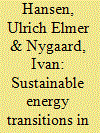

|
|
|
|
|
| Publication |
2014.
|
| Summary/Abstract |
The economic development in emerging economies in Southeast Asia has significantly increased the use of fossil fuel based energy. This has severe implications for global climate change, and against this background, scholars within the sustainable transition tradition have taken an interest in addressing how transitions towards more sustainable development pathways in this region may be achieved. This paper contributes to the abovementioned literature by examining the conducive and limiting factors for development and proliferation of a palm oil biomass waste-to-energy niche in Malaysia during the period 1990-2011. Rising oil prices, strong pressure on the palm oil industry from environmental groups, and a persisting palm oil biomass waste disposal problem in Malaysia appear to have been conducive to niche proliferation, and on top of this national renewable energy policies and large-scale donor programmes have specifically supported the utilisation of palm oil biomass waste for energy. However, in spite of this, the niche development process has only made slow progress. The paper identifies reluctant implementation of energy policy, rise in biomass resource prices, limited network formation and negative results at the niche level, as the main factors hindering niche development.
|
|
|
|
|
|
|
|
|
|
|
|
|
|
|
|
| 20 |
ID:
133042


|
|
|
|
|
| Publication |
2014.
|
| Summary/Abstract |
This paper examines whether initiatives to promote hydroelectricity consumption are likely to be effective by applying univariate and panel Lagrange Multiplier (LM) unit root tests to hydroelectricity consumption in 55 countries over the period 1965-2011. We find that for the panel, as well as about four-fifths of individual countries, that hydroelectricity consumption is stationary. This result implies that shocks to hydroelectricity consumption in most countries will only result in temporary deviations from the long-run growth path. An important consequence of this finding is that initiatives designed to have permanent positive effects on hydroelectricity consumption, such as large-scale dam construction, are unlikely to be effective in increasing the share of hydroelectricity, relative to consumption of fossil fuels.
|
|
|
|
|
|
|
|
|
|
|
|
|
|
|
|
|
|
|
|
|